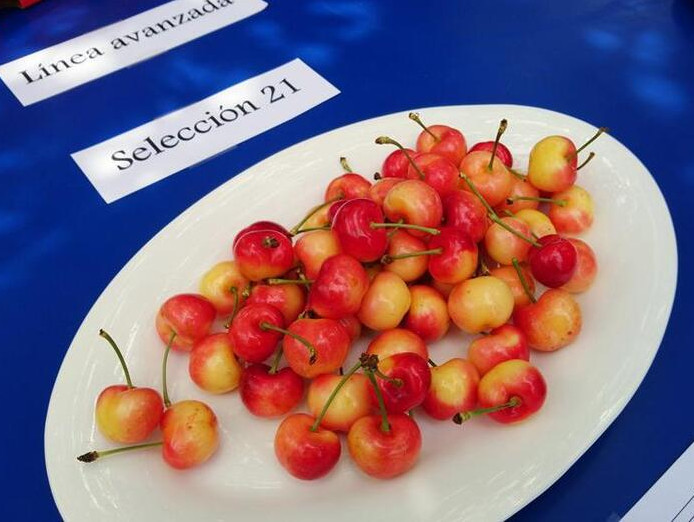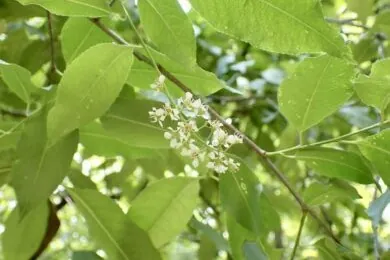The Makarska highlands in southern Croatia are characterized by a specific microclimate and extremely rocky soils, distinguishing agricultural production in this region from other parts of Croatia. These two factors create unique conditions for sustainable and organic farming.
Based on a knowledge exchange cross-visit organized within the OrganicAdviceNetwork project, this article presents insights into how these natural features contribute to the organic production of olive trees and the local sour cherry variety – Marasca. The microclimate results from mixing Mediterranean and continental influences, creating frequent winds, most notably the “bura”, which blocks cold continental air and leads to mild winters and hot summers.
These conditions are ideal for organic farming and help limit land encroachment. Moreover, the region’s rocky, karstic soil allows minimal mechanical interventions, preserving soil structure and reducing the need for external plant protection products, thereby enhancing soil quality. Despite its rocky structure and low organic matter content, the soil is fertile for these fruit trees.
Their deep roots prevent waterlogging, while the high limestone content provides essential minerals, making the soil balanced, mineral-accessible, and non-toxic. Here, fertility is about resilience, slow nutrient cycling, and natural balance, rather than high nitrogen content.
Soil characteristics of the region
Rocky soils enriched by limestone in a combination of the region’s wind-driven microclimate contribute to soil quality by fostering slow nutrient cycling, preventing compaction, and supporting a stable, low-input ecosystem ideal for long-term cultivation.
The Makarska region is a part of the Dinaric karst system. This Croatian landscape is defined by limestone bedrock and Mediterranean climatic conditions. These so-called karstic environments form through the slow dissolution of carbonate rocks, producing rugged topography and soils that develop extremely slowly, taking thousands of years to accumulate a few millimeters of fertile soil.
The soil profile of this terrain is a mixture of thin, rocky soils, with patches of deeper soil, Terra Rossa (commonly in soil depressions), a clay-rich soil with high nutrient retention. These soils are often shallow, stony, and prone to drought, erosion, and nutrient leaching.
The terrain often features long and narrow cracks of rocks, which accelerate drainage, which, although beneficial for some drought-tolerant crops, results in limited water retention and organic matter loss (SOIL RESOURCES OF CROATIA, b. d.).
Challenges and strategies
With erosion rates reaching up to 32 t/ha annually on slopes, particularly where vegetation is disturbed, maintaining soil integrity in the region requires careful land-use strategies and long-term ecological sensitivity (Agriculturae Conspectus Scientificus, 2007).
These characteristics of the Makarska region and the production of sour cherry and olives were presented during a cross-visit, organized by SEASN as a part of the OrganicAdviceNetwork project. At the cross-visit, many advisors from the region have participated, as well as advisors abroad.
With the viewing of two organic farms, an olive farm called Jurin Dvor, and a sour cherry farm called Terra Marascae. The region’s characteristics, fruit production, and challenges were well-presented to all participants by farmers as well as local advisors.
Later, with an interactive discussion, we have analysed all the knowledge gained from the cross-visit. This article is a description of all the information and aspects gained from the cross-visit, supported by a research background.
Managing karst terrain
The main characteristic of the Makarska region is rocky terrain, which is significant for karstic terrain. Two farmers overcame the challenge of growing olive trees and sour cherry trees in this soil. Their production is challenged because Karst terrain significantly limits soil fertility through both physical and chemical constraints.
The low proportion of insoluble residue left by limestone washing results in soil profiles that are rarely deeper than 50 cm. On the other hand, tree roots do not penetrate as deeply, and due to low organic matter in soil, the water retention is low, meaning nutrients such as nitrogen and phosphorus are commonly deficient due to leaching and chemical fixation in the alkaline environment (pH 7,5 – 8,0).
Organic matter levels are typically low, ranging between 76–116 g/kg, usually in deeper terrain depressions, making biological activity and microbial biomass fragile and dependent on vegetation cover. Because of the high presence of limestone, the calcium and magnesium are abundant, phosphorus often forms insoluble compounds, and potassium availability remains marginal, requiring foliar fertilization and organic principles to sustain plant growth and development.
That is why the farms approach the production with sustainable management practices. Two farms challenged this terrain, finding abundant soil and appropriate terrain. They expressed that, even though in places where the topsoil is covered in rocks, underneath it, there is a presence of little but high-quality organic soil.
Farm-level practices
For better production, they also decided to bring in fertile soil, or dig into the hill, to expose fertile soil. Overall, the encroachment on the soil during the production is very low. Due to the presence of rocks, they mainly (or only) use stone crusher machinery.
This is also beneficial, because while crushing the stone between rows, the dust the machine creates blows the pests of the trees – the pests fall off the tree with the weight of the dust. These approaches, soil composition, combined with suitable microclimate, make ideal conditions for organic production.
Despite the limitations, traditional Mediterranean crops like olives and sour cherries have adapted to the specific conditions of the karst landscape. Olive cultivation requires substantial initial investment. Farmer of the organic olive farm Jurin Dvor had to clear surface rocks and import soil, but once they established the terrain, native varieties such as Oblica, as well as foreign, such as Leccino (Italy), show good adaptation to mineral-rich but nutrient-poor soils.
However, the success of olive groves is tightly linked to irrigation, as rapid drainage in karst areas leads to drought stress and yield reductions. Studies show that irrigation can boost oil yield by up to 74%, with regulated deficit irrigation balancing water efficiency and oil quality.
Sour cherry adaptation
While sour cherry production typically requires favorable soil conditions, the domestic sour cherry variety Marasca has shown remarkable success even under the challenging conditions of the Makarska region.
The Marasca cherry is a small, dark red sour cherry known for its intense color, high sweetness (reaching over 30°Brix), and rich concentration of bioactive compounds – particularly antioxidants and melatonin, the highest among all cherry varieties. It has a strong aroma and complex flavor, making it ideal for both fresh consumption and processing.
These characteristics are significantly influenced by the growing environment. The Marasca thrives in sun-drenched Mediterranean conditions that are typical of the Makarska region. As such, it stands out as a nutrient-rich, health-boosting fruit with a distinctive and robust taste.
These sour cherry trees perform best in sandy soils with slightly acidic pH, which contrasts sharply with the alkaline, rocky conditions of most karst terrain. Nevertheless, Maraska can thrive in karstic depressions where deeper Terra Rossa soils are present.
Soil and water management
In these zones, higher anthocyanin and polyphenol contents are achieved, contributing to fruit quality, although yield remains sensitive to water availability and spring frost exposure, especially due to early flowering in April. Irrigation and organic fertilization are very important in these pockets to support root development and stabilize productivity.
But on farm assessment, the farmers have found that irrigation in the later developmental stages (when the trees are older), the irrigation is not as vital as in the beginning stages, since specific Microclimate creates good conditions, which makes use of irrigation only critical in the drought phases of the growing year.
Erosion control through terracing and grass cover is also important to prevent loss of these limited fertile areas. The Mediterranean climate is characterised by intense sunlight, dry summers, the moderating effect of the Adriatic Sea, and the influence of local winds such as the “bura”.
While continental A continental climate features hot summers, cold winters, and significant temperature shifts between seasons. Precipitation is moderate, snow is common in winter, and the growing season is relatively short.
Climate synergy and challenges
The Makarska region, specifically where two farms are located, is a location where the two climates – Mediterranean and continental – mix. This plays a crucial role in the success of olive and sour cherry cultivation.
For olives, long exposure to sunlight enhances photosynthesis and biosynthesis of oils, while the daily temperature range – warm days followed by cooler nights – favors slow ripening, sugar accumulation, and the development of polyphenolic compounds.
This supports the production of high-quality oil with specific and balanced bitterness as well as spiciness from domestic varieties like Oblica. The sea’s influence reduces frost risk and stabilizes flowering, while occasional bura episodes help suppress disease pressure by reducing humidity.
In sour cherry cultivation, the same climatic features present a double-edged sword. While mild winters usually ensure sufficient chilling hours, late spring bura-induced cold snaps can damage blossoms during flowering. Additionally, shallow, stony karst soils with limited water retention make trees vulnerable to drought during hot summers.
Conclusions from the cross-visit
However, in karst depressions with deeper soils and slightly moderated conditions, Maraska sour cherries can develop superior fruit quality, with elevated anthocyanin and polyphenol content.
Farmers expressed the importance of the influence of the mixing of two climates. This phenomenon creates the mixing of the air (described as “bura”), which is beneficial, since it creates windy conditions for approximately 18 hours a day.
This is a very important factor for the occurrence of pests and diseases. Meaning, there is a very low occurrence of pests and diseases, which makes ideal location and climate for organic production. But they described that they face new challenges, caused by climate change.
Climate change mainly affects the flowering stage. Since the temperatures are higher, it causes early flowering, making it more susceptible to later frost, potentially to yield losses.
Soil limitations and adaptation
The soil in Croatia’s Makarska region is defined by its karstic nature – shallow, rocky, and low in organic matter – providing challenging conditions for cultivation. The fertile soil that is found in the terrain is usually topsoil, and in depressions, it appears as Terra Rossa.
Moreover, water retention is very low due to the limestone composition, which features many fractures in the rock, causing nutrient deficiencies such as nitrogen and phosphorus. On the other hand, the weathering of limestone provides sufficient nutrients such as calcium and magnesium.
Despite these limitations, farmers have adapted to the cultivation conditions of the region. In the case of the olive tree farm Jurin Dvor, the terrain had to be prepared for olive cultivation, while the Terra Marascae farm searched for the most suitable location and planted the domestic sour cherry variety – Marasca.
During the cross-visit, farmers shared practical insights and strategies for fruit cultivation in the region. They expressed that although the soil quality is not ideal, when combined with the specific microclimate of the location – a mix of Mediterranean and continental climates – it creates ideal conditions for the organic cultivation of olives and sour cherries.
Both factors give the final product distinctive traits in flavor and chemical composition, making it very specific to the region and resulting in high-quality fruit. Moreover, farmers described how the region’s terrain and microclimate together provide ideal conditions for practicing organic production.
The rocky terrain results in low soil erosion, requiring only the use of rock crusher machines, while the presence of the “bura” wind and generally windy conditions lead to a low occurrence of pests and diseases, reducing reliance on pesticides.
Source: stratusproject.eu
Image source: Marascae
Urban Hrovatič , Domagoj Gorup
Rete di servizi di consulenza per l'Europa sudorientale (SEASN), Zagabria, Croazia
Italian Berry - All rights reserved












